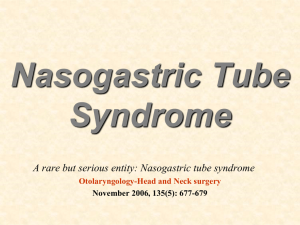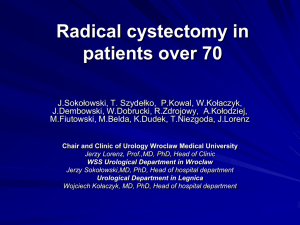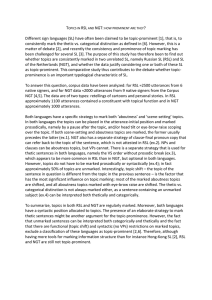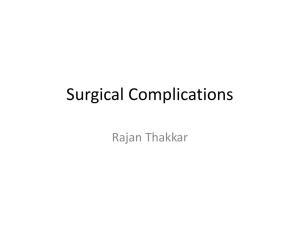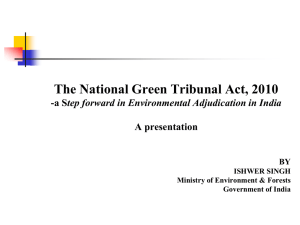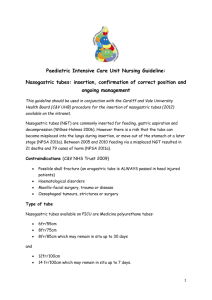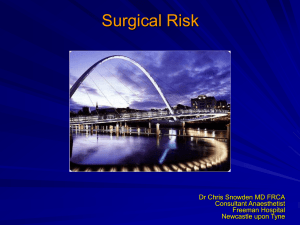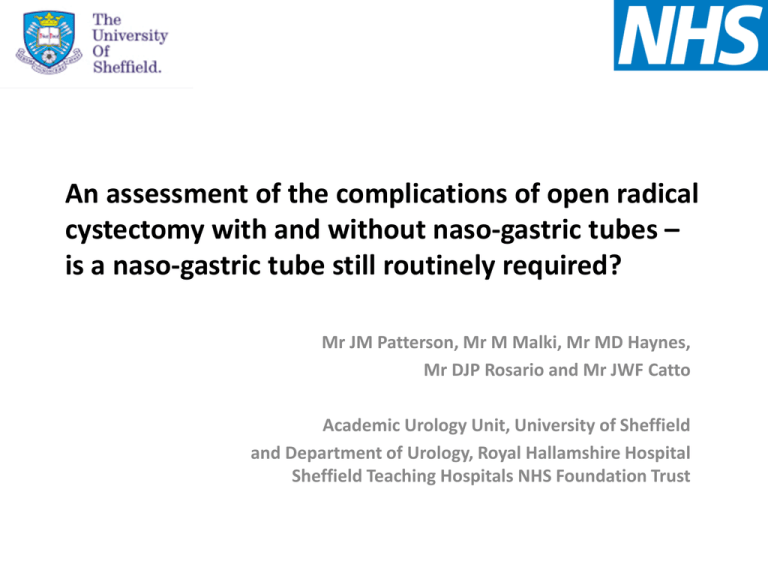
An assessment of the complications of open radical
cystectomy with and without naso-gastric tubes –
is a naso-gastric tube still routinely required?
Mr JM Patterson, Mr M Malki, Mr MD Haynes,
Mr DJP Rosario and Mr JWF Catto
Academic Urology Unit, University of Sheffield
and Department of Urology, Royal Hallamshire Hospital
Sheffield Teaching Hospitals NHS Foundation Trust
Introduction
• Cystectomy is a morbid procedure
– RT, GIT and UT/renal complications; mortality
• Patients dislike nasogastric tubes and they are
associated with respiratory complications
• ERAS protocols have been introduced to
improve LoS and other morbidity factors
• Can morbidity be reduced by removing the
routine use of NGT?
Methods and patients
• Null hypothesis: Not using NGT will prolong
ileus and increase complications
• Prospective evaluation of 57 patients
undergoing open radical cystectomy
• Single institution, 3 surgeons
• 2 surgeons stopped placing NGT, 1 continued
• 12 month study period, followed up for 6-18
months
Methods and patients
No NGT (n=21)
NGT (n=36)
Overall
Sex
13♂:8♀
30♂:6♀
43♂:14♀
Age
70.1 (59-83)
66.6 (55-80)
67.9
Procedure duration
4h (2.75-5)
5.75h (4-9.33)
5.1h
Blood loss
825ml (370-1700)
1475ml (400-3870)
1245ml
Time to bowels open
7.35d (med 6d)
7.51d (med 7d)
7.46d (med 7d)
Time to NG out
-
4.6d
4.6d
Length of stay
12.9d (med 13)
13.3d (med 12)
13.16d (med 12)
Final pathology:
•15 pT0, 9 pTis, 3 pTa, 4 pT1, 15 pT2, 7 pT3, 4 pT4.
•13 N+ (4 pN1, 8* pN2, 1 pN3)
*including an incidental lymphoma in pelvic nodes
•1 M+ (separate vaginal nodule to main tumour-G3pT2).
•11 incidental CaP
•53 Urothelial Ca (+2 Neuroendocrine differentiated), 1 AdenoCa, 1 SqCCa
•2 primary urethrectomy, 1 salvage cystectomy. All ♀ done as ant. exenteration
Results
• No difference in LoS (orthotopics excluded)
• No difference in time to return of GIT transit
• No difference in rates of DVT/PE or wound
dehiscence (nil both groups), or cardiovascular
or stomal complications
• However, other complications do differ
Results
• Complications
– 1 death in each group
• 188 days post op in NGT- group – pT4 disease, 79yo
• 159 days post op in NGT+ group – post salvage surgery,
complications included enterocutaneous fistulae, T3b
sarcomatoid tumour, 72yo
– NGT related
• 4 inserted in NGT- group (19%)
– 2 only for 24h, 1 for chronic constipation, 1 for ileus
• 4 reinserted in NGT+ group (11%)
– 1 resited in PACU, 2 for 24-48h only, 1 for SB complications
Results
• Complications
No NGT
NGT +
Wound infection
3 (14%)
10 (28%)
Chest infection
1 (5%)
4 (11%)
Nutritional
1 (5%) needed TPN
4 (11%) needed TPN
Other infections
2 diarrhoea, 1 sepsis ?focus
2 diarrhoea, 1 C Diff, 2 sepsis
?focus, 1 urosepsis
Others
1 persistent drain output, 1
revision UI anastomosis
1 enterocutaneous fistula, 2
scrotal haematoma, 1 revision
stoma, 1 conversion neobladder
to conduit, 1 laparotomy and
adhesiolysis
Overall
10 in 8 patients (38%)
30 in 18 patients (50%)
Discussion
• No result statistically significant
• Trend towards more complications in longer
operations (mean duration 5.3 v 4.9h without
complication), paralleled by blood loss
• NGT negatively associated with
– respiratory complications
– wound infections
– overall complications
Conclusions
• Routine NGT placement after open radical
cystectomy is not recommended
– increased complications in this series
– but up to 20% may need NGT insertion
• senior clinician decision to avoid unnecessary NGT
• Longer operating times seem to be correlated
with blood loss, and increased complications

